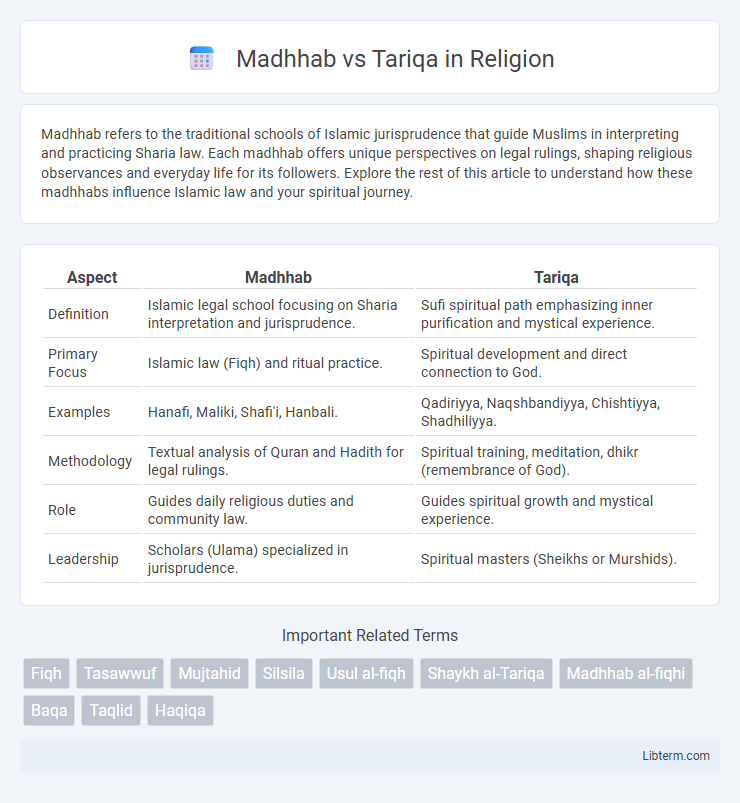Madhhab refers to the traditional schools of Islamic jurisprudence that guide Muslims in interpreting and practicing Sharia law. Each madhhab offers unique perspectives on legal rulings, shaping religious observances and everyday life for its followers. Explore the rest of this article to understand how these madhhabs influence Islamic law and your spiritual journey.
Table of Comparison
| Aspect | Madhhab | Tariqa |
|---|---|---|
| Definition | Islamic legal school focusing on Sharia interpretation and jurisprudence. | Sufi spiritual path emphasizing inner purification and mystical experience. |
| Primary Focus | Islamic law (Fiqh) and ritual practice. | Spiritual development and direct connection to God. |
| Examples | Hanafi, Maliki, Shafi'i, Hanbali. | Qadiriyya, Naqshbandiyya, Chishtiyya, Shadhiliyya. |
| Methodology | Textual analysis of Quran and Hadith for legal rulings. | Spiritual training, meditation, dhikr (remembrance of God). |
| Role | Guides daily religious duties and community law. | Guides spiritual growth and mystical experience. |
| Leadership | Scholars (Ulama) specialized in jurisprudence. | Spiritual masters (Sheikhs or Murshids). |
Understanding Madhhab: Foundations of Islamic Jurisprudence
Madhhab represents the foundational schools of Islamic jurisprudence, guiding the interpretation and application of Sharia law through established legal principles and methodologies derived from the Quran, Hadith, consensus (Ijma), and analogical reasoning (Qiyas). Major Madhhabs like Hanafi, Maliki, Shafi'i, and Hanbali structure the practical aspects of worship, transactions, and personal law, ensuring consistency and adaptability within diverse Muslim communities. Understanding Madhhab involves recognizing its role in legal theory (fiqh) and its influence on daily religious practices, contrasting with Tariqa which emphasizes spiritual paths and mystical experiences in Sufism.
Tariqa Explained: The Spiritual Path in Islam
Tariqa represents the spiritual path in Islam, emphasizing inner purification, direct experience of the Divine, and personal transformation through Sufi practices such as dhikr (remembrance of God) and meditation. Unlike Madhhab, which refers to jurisprudential schools defining Islamic law and rituals, Tariqa guides the seeker toward mystical understanding and closeness to Allah through mentorship under a spiritual guide or Sheikh. The Tariqa fosters deep spiritual connection, transcending legalistic adherence to focus on the heart's development and the soul's journey toward divine truth.
Historical Origins: Emergence of Madhhab and Tariqa
Madhhabs emerged between the 8th and 10th centuries as formal schools of Islamic jurisprudence, each developing systematic legal methodologies based on the Quran, Hadith, and consensus of early scholars. Tariqas originated in the 12th century as spiritual paths within Sufism, emphasizing mystical practices and personal experiences to attain closeness to God. The historical divergence reflects Madhhabs' focus on external law and Tariqas' emphasis on inner spiritual purification.
Key Differences Between Madhhab and Tariqa
Madhhab represents a school of Islamic jurisprudence focused on interpreting Sharia law, guiding legal and ritual practices based on foundational texts and scholarly consensus. Tariqa, in contrast, denotes a spiritual path or Sufi order emphasizing personal mysticism, inner purification, and direct experience of the divine through practices like dhikr and meditation. While Madhhab addresses external religious law and communal norms, Tariqa concentrates on inner spiritual development and experiential knowledge of God.
The Role of Madhhab in Islamic Law and Practice
Madhhab represents a school of Islamic jurisprudence that provides structured interpretation and application of Sharia law in daily worship and legal matters. It guides Muslims in ritual practices, personal conduct, and jurisprudential decisions by deriving rulings from the Quran and Hadith using established methodologies. The role of Madhhab is crucial in maintaining consistency and scholarly consensus within Islamic legal tradition across diverse Muslim communities.
The Significance of Tariqa in Sufism
Tariqa holds a pivotal role in Sufism as the spiritual path guiding seekers toward divine truth and direct experiential knowledge of God, transcending mere legalistic practice found in Madhhab. While Madhhab defines jurisprudential frameworks for daily religious observance, Tariqa emphasizes inner purification and mystical realization through rituals, meditation, and guidance from a Sufi master. The transformative journey within Tariqa cultivates spiritual awareness and union with the Divine, distinguishing it as the heart of Sufi practice.
Intersections and Overlaps: Where Madhhab Meets Tariqa
Madhhab and Tariqa intersect where Islamic jurisprudence and spiritual practice converge, highlighting how legal frameworks shape mystical pathways within Islam. Madhhab provides the foundational fiqh principles, while Tariqa embodies the experiential, inward journey, often reflecting adherence to specific madhhab rulings in ritual observances. Overlaps occur as many Tariqas align with a particular Madhhab, integrating its legal interpretations to maintain orthodoxy while pursuing spiritual purification.
Prominent Schools: Examples of Madhhab and Tariqa
Prominent Madhhabs include the Hanafi, Maliki, Shafi'i, and Hanbali schools, each representing a distinct methodology for Islamic jurisprudence and legal interpretation. Well-known Tariqas, such as the Qadiriyya, Naqshbandiyya, Chishtiyya, and Suhrawardiyya, emphasize spiritual practices and Sufi mysticism aimed at inner purification and closeness to God. These schools, Madhhab and Tariqa, serve complementary roles where Madhhab guides daily legal adherence and Tariqa fosters personal spiritual development.
Contemporary Relevance: Madhhab and Tariqa Today
Madhhab and Tariqa remain pivotal in shaping contemporary Islamic identity and practice, with Madhhab providing structured jurisprudential frameworks guiding daily rituals and legal decisions, while Tariqa offers personalized spiritual pathways emphasizing inner purification and mystical experience. In modern Muslim societies, adherence to specific Madhhabs helps maintain continuity in Islamic law amidst diverse cultural contexts, whereas Tariqas contribute to social cohesion and spiritual resilience through communal rituals and Sufi orders. The interplay between Madhhab and Tariqa demonstrates the dynamic balance between normative law and spiritual enrichment, addressing both external compliance and internal transformation in contemporary religious life.
Navigating Unity and Diversity: Balancing Madhhab and Tariqa
Madhhab represents the established schools of Islamic jurisprudence, providing structured legal frameworks that guide daily worship and societal conduct, while Tariqa embodies the mystical spiritual paths emphasizing personal divine experience and inner purification. Balancing Madhhab and Tariqa requires recognizing the practical legal boundaries of fiqh alongside the transformative spiritual practices of Sufism, fostering unity among diverse Muslim communities. Navigating this balance enhances both religious adherence and spiritual depth, promoting harmony within Islamic traditions without compromising doctrinal integrity.
Madhhab Infographic

 libterm.com
libterm.com